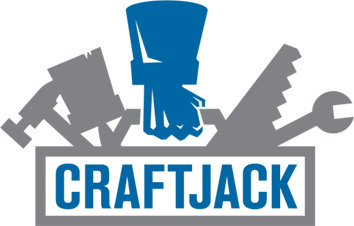General Contractor Business Plans: A Guide | CraftJack
Creating a general contractor business plan is a great way to set company goals and access financing. Get started now at CraftJack.

Whether you build new homes or focus on additions and home remodeling, creating a general contractor business plan is like setting a strong, sturdy foundation to support future business growth. This inclusive document tells you and other readers, including financial partners and potential investors, what your company does and why. It can help you assess your company's strengths and weaknesses in relation to industry trends and standards, turning a hazy business idea into a well-defined and potentially lucrative economic opportunity.
Ready to grow your construction business? Join CraftJack to get fresh leads from local customers in your service area.
What Is a Business Plan?
A business plan is a multi-part document that describes what your business does. It looks at a variety of areas, such as services, staffing, financing, marketing, and daily operations. The purpose of this document is to set goals and create a road map that helps your business grow over the next 3 to 5 years. It doesn't just tell readers what you hope to accomplish; it also describes how you'll achieve your goals.
Do General Contractors Need a Business Plan?
Absolutely! As great thinkers like Benjamin Franklin and Winston Churchill noted, failing to plan is planning to fail. Taking the extra time to write and refine a business plan is essential to defining your goals, identifying your customer base, and building a successful strategy for enjoying sustained growth. It's also a valuable tool for securing financing and attracting talent. Finally, a business plan can help you assess your company's strengths and weaknesses while pinpointing potential blind spots that could make you vulnerable to competitors.
What to Include in a General Contractor Business Plan
Most business plans follow a standard 10-part format. This type of document takes time to create, but it provides an in-depth look at your business and overarching strategies. Traditional business plans may be several dozen or even 100 pages long, depending on the size of your business. Lenders and investors typically request this type of document. Another option is to create a lean startup business plan. This is usually just one to two pages long and summarizes key points about your organization.
10 Parts of a Traditional Business Plan
1. Executive Summary
This introductory section tells readers what your construction business is all about in a nutshell. You should mention your products or services, key leadership figures, mission statement, geographic service area, target customers, and plans for future growth.
2. Company Description
Use this section of your business plan to tell readers what makes your company unique. Key points to hit include your company's goals, areas of expertise, and competitive advantages or market differentiators. You may also want to mention your industry experience, customer base, and any other strengths that may contribute to your company's success, such as a large service area or the ability to undertake complex projects.
3. Market Analysis
This section of your business plan should focus on your customers and competitors. It looks at the big picture to describe what's happening in your industry locally and nationally. Research direct and indirect competitors to see what works and what doesn't. Consider what you can do to tailor your services to the local market.
4. Business Structure
This section should describe your company's legal structure. As an example, many general contractors choose to incorporate or establish a limited liability company (LLC) to limit personal and financial responsibility in case something goes wrong. You can also highlight leadership figures, including their industry experience and qualifications. Resumes and supporting documentation should be included in the appendix at the end of your business plan.
5. Services
The next step is to highlight the services you offer and how they benefit your customers. You may build new homes from start to finish or focus on simple remodeling and home repairs. State how much of your business is devoted to each segment. Be sure to mention all the services you offer, including plumbing, electrical, framing, and masonry, as well as any value-added offerings, such as landscaping, excavation, and window or door replacement.
6. Marketing
A strong sales strategy is needed to support a successful construction business. Use this section of your business plan to describe strategies for marketing and promoting your business, reaching target customers, and pricing your products and services. Focus on the four P's of marketing: product, price, place, and promotion. Tell readers how you'll target customers. Examples of marketing strategies include direct mailers, TV ads, telemarketing, digital advertising, word of mouth, and cross-promotion.
7. Operations
Your operations plan tells readers how you'll achieve short- and long-term goals and run your business on a daily basis. As a contractor, you need to have a plan for securing leads and preparing estimates and contracts. Subcontractors, suppliers, and project management skills are critical for your company's success. You should also cover strategies for billing, scheduling code inspections, and meeting internal quality standards. Describe all resources needed to achieve major goals, such as expanding your service area, increasing your revenue, or accepting larger projects.
8. Management
It takes talent and human capital to create and manage a successful construction business. This part of your business plan shows stakeholders who's part of your team. If you have a small construction company, you may be responsible for handling a variety of responsibilities, or you may depend on others to fill these rolls.
The goal of this section is to show that your company has capable leaders. Mention key personnel and their industry expertise. If you have investors or consultants, mention their credentials. Lawyers, accountants, and architects may also be instrumental to your operations. Finally, outline any new staffing requirements that may be needed to achieve your goals.
9. Financial Projections
Depending on how long your company has been in business, this section should detail your organization's finances over the past 3 to 5 years. You should also show investors where revenue will be coming from in the future. This is a great place to include visuals such as charts and graphs. Here are some items to include.
- Balance sheets showing assets and liabilities
- Cash flow statements showing how assets enter and leave your company
- Income/profit and loss statements showing income and expenses
- Capital expenditure budget showing estimated fixed asset purchases
- Collateral and financing, such as loans and assets
10. Appendices
The final section of your business plan should contain supporting documentation that corroborates your claims and establishes your expertise. Here are some common items to include:
- Resumes for key personnel
- A copy of your general contractor license
- Letters of incorporation
- Pictures of previous work
- Credit reports
- Financial records
- Permits
- References
- Copies of contracts
- Insurance policies
- Construction bonds
Creating a Lean Business Plan
Lean business plans aren't as common, but they are easier to create. While they provide a variety of information at a glance, lenders may ask for additional documentation, especially if you're asking for financing for a new construction or residential development. For this reason, you may want to create a full business plan and a lean version. Lean business plans typically have nine parts.
1. Partners
List key partners, such as suppliers, subcontractors, and architects, that are instrumental to your company's success.
2. Competitive Advantage
Detail items that give your construction firm a competitive advantage. Focus on things like in-house services, building capabilities, equipment, technology, and geographic reach.
3. Resources
Highlight resources that are needed for short- and long-term success, such as staffing, licensing, insurance, collateral, and financing.
4. Value Proposition
Create a compelling statement that describes how your construction services meet customers' current and future needs.
5. Customer Service
Describe how your business meets customers' needs throughout the home-building process, from delivering estimates and bids to scheduling subcontractors and meeting quality control standards.
6. Demographics
Use demographic data to describe your ideal customer. Include details like age, gender, income, geographic location, and household size.
7. Marketing Channels
Tell readers how you'll target your customers. Examples include print advertising, door-to-door sales, word-of-mouth marketing, and referrals.
8. Costs
Analyze the cost of doing business. Detail all expenses, including labor and materials, as well as ways to control your overhead and operating costs.
9. Finances
Describe how your business will access funding and make money. Project expected income, profits, and expenses, including capital expenditures needed for tools and heavy equipment.
Do's and Don'ts
Creating a business plan isn't easy, but it is worthwhile. For best results, be realistic and follow these do's and don’ts.
- Do evaluate your business from multiple perspectives.
- Do update your business plan regularly.
- Do consider how your business reflects customers' needs.
- Do base your business strategies on actual market conditions.
- Do make accurate projections without being stingy or overly optimistic.
- Do look at examples and business plan templates for more ideas.
- Don't wait to create a business plan. You can start this document before you incorporate.
- Don't make unsubstantiated claims as lenders and investors will ask for verification.
- Don't overlook the needs of consumers, lenders, and stakeholders.
- Don't underestimate potential risks or threats.
- Don't hesitate to consult a mentor or SBA consultant if you need assistance.
- Don't forget to implement the strategies that you've developed.

Advantages of General Contractor Business Plans
According to government data, over 5 million new businesses are started every year. Unfortunately, about 20% of these businesses fail in the first 2 years, according to the Bureau of Labor Statistics, and many more fail between years 5 and 10.
While there's always a need for home repairs and new construction, contractors have one of the highest rates of business failure compared to all industries. Creating a strong, well-thought-out plan backed by market research can greatly increase the odds that your contracting business will outlast the competition. Here are a few ways a general contractor business plan can help your company succeed.
- Business planning can help you set short-, long-, and mid-term goals based on market research.
- A well-crafted business plan can help you secure financing and investments needed to get bigger projects off the ground.
- Business plans also create a framework for managing financial resources and ensuring a healthy cash flow.
- Strong marketing plans can help your company weather seasonal slowdowns and economic downturns.
- Thorough operating plans can reduce excessive change orders that drive up costs and cut into profits.
- Detail-oriented management strategies can reduce delays and ensure permits and funds come through on time.
- Adequate financial planning can help builders access the funds needed to buy materials and acquire heavy equipment that's vital for business success.
- Strong quality control standards outlined in your operating plan can minimize extra expenses while limiting liability and claims.
- Business planning can help you identify potential gaps, such as staffing, marketing, or financing, that need additional attention.
- By looking at market conditions, you can determine whether it's the right time for a growth initiative or more conservative strategies.
Financial Benefits of Business Plans
In addition to helping you secure financial backing from commercial lenders, business plans provide a variety of financial advantages. By looking at data, you can determine which products or services are most profitable.
For example, financial planning helps you assess fixed and variable costs. Once you have these numbers, you can complete a break-even analysis. Your break-even price equals your fixed costs divided by your average sales price minus variable costs.
You can also determine your charge-out rate. To do this, divide your desired income by the number of billable hours in a given year. For example, if you work 6 hours a day for 230 days of the year with 6 weeks off for vacation and personal time, you have 1,380 billable hours. To earn $250,000, you must charge about $180 per hour.
Planning can also help you reduce financial risks related to workplace injuries, environmental regulations, and laws related to employment, building codes, and business ethics. Minimizing financial risks can help your business remain solvent while ensuring you have enough money to pay workers, subcontractors, and suppliers.
Implementing Your Business Plan
Creating your business plan is only half the battle. This document isn't designed to sit in your filing cabinet or lay dormant on your computer's hard drive. Once you have a business plan in place, it's time to put it to work. Here are a few ways to use your business plan.
- Evaluate the viability of new ventures and strategies.
- Inform potential partners or employees about your business.
- Assess your company's performance.
- Track progress toward key goals.
- Manage potential threats and risks.
- Maintain a competitive edge.
- Win important contracts.
- Secure financing or backing.
- Develop a successful exit strategy.
- Prepare for a buyout or change in ownership.
Next Steps: Refining Your Business Plan
Like building a home, creating a business plan isn't a one-and-done job. Once the project is finished, you still need to maintain the final product. Business plans are iterative documents designed to be adjusted as your company changes and grows. While there's no hard-and-fast rule, business plans should generally be updated every year or in the following situations.
- Following leadership or management changes
- When offering new services or incorporating new technologies
- To address up-and-coming competition
- Responding to market or industry changes, such as fluctuating interest rates
- Following business milestones, such as 100 homes complete or a shift to high-end builds
- Securing new forms of financing or backing
Creating a general contractor business plan is just one part of growing a successful construction company or home service firm. This document can work in tandem with other marketing strategies, such as lead building and social media, to help you achieve your business goals and build a respected brand. For more ways to grow your business as a general contractor, sign up with CraftJack. We provide verified local leads for general contractors and professionals in the skilled trades with no monthly fees. Get started today.



